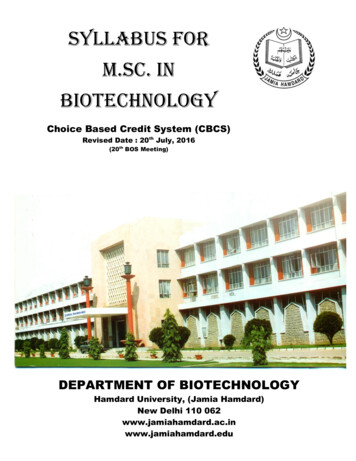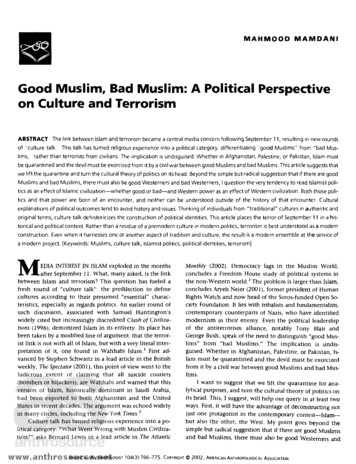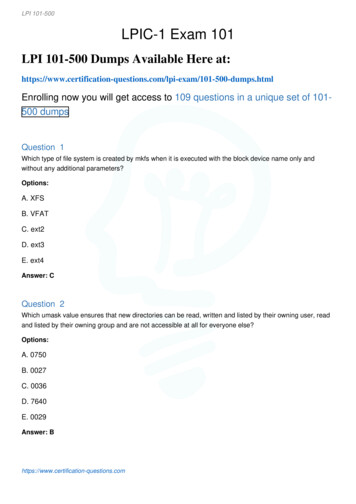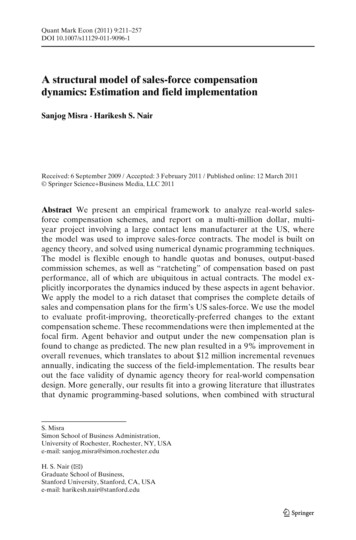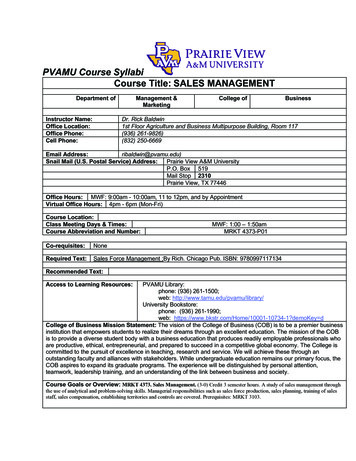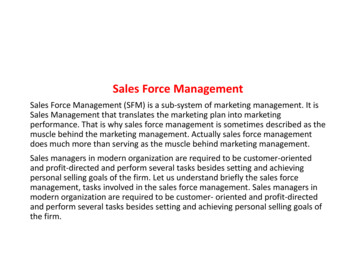
Transcription
Sales Force ManagementSales Force Management (SFM) is a sub-system of marketing management. It isSales Management that translates the marketing plan into marketingperformance. That is why sales force management is sometimes described as themuscle behind the marketing management. Actually sales force managementdoes much more than serving as the muscle behind marketing management.Sales managers in modern organization are required to be customer-orientedand profit-directed and perform several tasks besides setting and achievingpersonal selling goals of the firm. Let us understand briefly the sales forcemanagement, tasks involved in the sales force management. Sales managers inmodern organization are required to be customer- oriented and profit-directedand perform several tasks besides setting and achieving personal selling goals ofthe firm.
Recruitment and Selection of Sales PersonnelRight salesmen can help company achieve marketing objectives. Recruitmentand selection are two important decisions in sales force management thatconcern with ensuring the right type (right qualities, right qualifications, andright experience) of sales personnel.Recruitment:Recruitment means searching for prospective candidates and inspiring them toapply for the post. Recruitment ends on the last day/date of receivingapplications. Salesmen can be recruited through a number of sources.Main sources, widely practiced in India, includes:1. Advertisement2. Other firms3. Middlemen
4. Personal recommendations5. Recommendation of existing staff6. Special recruitment agencies7. Private training institutes8. Colleges and academic institutes, etc.Types of sources to be used for recruiting the salesmen depend on certaincriteria, like type of products to be sold, types of customers to be served, payingcapacity of company and type of remuneration plans, and other relevant factors.
Selection:Selection means selecting the fixed number of suitable candidates from thosewho applied for the posts. Selection process starts as soon as recruitment ends.Recruitment considers all applications received in a due date while selectionconsiders only the required number of most suitable candidates.There is no ideal selection process that most companies can follow. Normally, forselecting salesmen, the simple and short selection process is followed. However,some companies, when more salesmen are to be selected at time, also followlengthy and systematic selection process. Selection process depends on types ofsalesmen, cost and financial position of company, time available, company’sobjectives, and so forth.
Steps in Selection Process:Systematic selection process consists of following steps:1. Receiving applications2. Screening applications3. Preliminary interview4. Written tests5. Final interview6. Medical examination7. Final selection
8. Appointment and inductionImportant Conditions:At the time of final selection or appointment of salesmen, following conditionsmust be made clear:1. Time to resume the duty2. Company’ marketing objectives, policies, and strategies3. Duties and restrictions4. Place of work5. Reporting system or procedure6. Bill collecting system7. Remuneration and incentives8. Training and expenses9. Other relevant conditions, if any.
Motivate Sales-Force1. Recognition and praise:Salesmen, like any other human-beings, seek recognition for their achievementsand praise for the work done which they think is more than monetary gain forthem. The most common complaint of sales-force is that sales managers rarelypraise their work par excellence. Failure to compliment and praise is ignoring avital need in salesman’s nature having deeper impact on sales performance.2. Fair pay-packet:Though financial incentive is secondary to recognition and praise, it is dominantmotive because, every salesman is to earn a decent living for himself and hisdependents. It is but natural that he expects an assurance of the salary that iscomparable with his colleagues in his own organisation and the competitiveorganizations with equal performance and responsibilities. Therefore, it shouldbe attractive and assumed one.
3. Good working conditions:It is the working conditions both physical and psychological that influence his attitudetowards his work and performance. Thus, a salesman looks for a territory that giveshim adequate sales potential; he wants a protection against infiltration by othersalesman or salesmen in his territory; he expects a fair division of compensation onall joint sales efforts.He is likely to expect an adequate and regular expenseallowance, conveyance facilities or the reimbursement that effect. The other suchconditions may be freedom from excessive paper work, cozy office facilities’ length oftime away from home and so on.4. Opportunity for advancement:Good many sales-people give top priority to promotion to higher ups than to theattractive salary or even the job security. By nature, an employee does not want tobe tangent. It is the case with more ambitious, efficient and industrious salesmen.Any company that fails to promote or provide such an opportunity for advancementwill be responsible for high sales-force turnover by depriving the basic need andcreating dissatisfaction and injecting frustration.
5. Good supervision and leadership:The productivity of sales-force is dependent on the very nature of leadershipprovided in company from sales manager down to sales-supervisors. Every manageris a leader and not a boss.Salesman looks their superiors as outstanding in terms of industry and knowledge.Salesmen respect those who are fair and impartial, determined, keep words, andaccommodate the personal dignity of salesmen; they expect that their leader shouldunderstand them, their problems and solve them.6. Opportunity for self expression:Salesmen have their own views, attitudes, suggestions and ideas which they want toexpress, assert their personalities and exploit their latent talents and abilities. Asalesman is sure to increase his sales efforts if he has the opportunity to asserthimself, express his personality.Absence and suppression of salesman’s expression and assertion will kill his initiative,drive and enthusiasm. Management stands benefitted by such rich reserve ofuntapped source of new ideas of increasing sales, cutting costs and improvingprofitability.
7. Social acceptance:Every human-being, a social and rational animal has the strong feeling of ‘belonging’to a group of salesmen. Naturally, salesmen desire the acceptance and goodwill oftheir association in business.It is the sales manager’s task to develop a sense of ‘belongingness’ in case of everysalesman. He wants to have the satisfaction of being accepted as a member of salesteam, sales organisation, having his active participation, voice in its affairs,cooperating in matters of mutual interest.8. Job security:Every salesman expects that he has job security; that is, he will be able to retain hisjob so long as his work is quite satisfactory and the prevailing economic and socialconditions permit. Job security does not mean absolute permanence of job tenure.It means protection from arbitrary discharge or dismissal or transfer. Salary is not theonly factor that determines such security. He looks to future social security. When hegets old, he should have the opportunity of reasonable earnings to pull on longerwith respect and dignity.
9. Desire to excel:One finds the strong urge of excelling others in performance and theachievements. It speaks of aggressiveness of many successful salesmen. Desireto excel others implies increasing sales, cutting costs, improving profitability. It isa motive that helps both the parties in that the management can prosper andthat the prosperity is made to share by the sales-force.10. Pride in selling:In addition to job security, job satisfaction is one of the strongest motives ofevery salesman. This job satisfaction is dependent upon pride in selling as avocation. When one has accepted a sales career, it should not be looked downupon. The salesman should have a feeling that he is doing some worthless job tohang on or as a matter of last resort or as a means of livelihood.Therefore, the significance of selling must be emphasized in preparing andtraining the salesmen. They should be given an understanding that they aredoing creative, gainful, socially acceptable and respected job.
Compensating Sales PersonnelSales-force compensation is number one problem confronting every salesmanagement. Compensation, here, stands for the monetary and non-monetaryreward given by the firm to, its sales-force in return for the services rendered.Though, compensation stands for contractual payments, there can be noncontractual and ad-hoc payments.If sales-force recruitment and the training create and develop the manpowerneeds, the compensation aspect cares for its maintenance in the organisation forlonger period.Significance of sound compensation:Sales-force compensation is very important because, it directly affects not onlythe sales costs and the profits but, more significantly, the attitude, interest andthe behaviour of salesmen and the nature of their task.
Perhaps, the most difficult task is how to reconcile the conflicting objectives oflow sales costs and higher profits on one hand and adequate, attractive earningswith security, on the other.In that sense, no compensation plan is perfect that meets the needs ofmanagement in all respect satisfactorily and sales-force wholeheartedly. At thebest, it is the compromise between the two extremes. However; we cannotunderestimate a compensation plan that pays well its sales-force.In fact, the importance of paying well lies in the following points:1. To attract best salesmen:Gifted, talented and high caliber salesmen are available only at higher rewards,both monetary and non-monetary. Pay more and get the best. In fact, cheap iscostlier. Therefore, costlier is qualitative.
2. To keep sales-force contented:There is direct link between the payment made to the salesmen and theirsatisfaction. A person is supposed to perform his duties, look at his job wellwhen he is contented or satisfied. Satisfaction being a state of mind depends onwhat he gets in monetary and non-monetary forms for his job or the efforts putin.3. To have longing loyalty:The aim of personnel management is not just to build competent sales-force buthave a pool of selected persons expected to serve life-time for the nourishmentand nourishment of the selling house.Loyal and trust-worthy staff makes the organisation rich, dependable andsuccessful. Good pay-masters can expect this.
4. To have sound employer-employee relations:Bickering, misunderstandings and drags arise mostly due to money matterpartial or ill- treatment. The wheels of sales organisation must not squeak. Onesuch wheel is sales-force that can be kept in kilt if paid well and treated well. It isthe sound compensation plan that greases the squeaking wheel for frictionlessworking.Compensation Level:Level of sales-force compensation stands for what should be the reasonablecompensation for the efforts of the sales-force. Level of compensation issignificant to both the employers and the employees.It is but natural that sales-force expects higher rewards for its efforts and themanagement is intended to pay lesser amount. The actual level of compensationlies between what the companies intends to pay and the sales- force expects toreceive.
Whether the level of compensation is going to be high or low is dependent oncertain factors. In practice, the actual level of compensation is the compromiseof the interacting forces which are outlined below:1. Sales competence:The compensation level is bound to be higher in case of salesmen with calibre,competence or the sales acumen. It is the sales personality experience and otherattributes that decide the compensation payable.2. Extent of advertising:Sales efforts of sales-force are geared by promotional efforts too. Naturally,higher the level of advertising in the sales organisation, lesser will be the inputby the sales-force and hence, lower will be the level of compensation.
3. Degree of training:A highly trained salesman is quite capable of handling the sales job with ease,confidence and grip. However, the company has invested in him to make himworthy of the sales profession. Hence, more the training intensity, lower will bethe compensation level.4. Financial viability:It is the financial strength and viability of a sales organisation that puts limits onthe levels of compensation. Normally, a company which is well to do will nothesitate to pay higher compensation than the one with moderate means.5. Bargaining power:Leaving aside the quality, caliber of salesmen, it is the bargaining capacity thatplays a decisive role in putting higher limits. Thus, stronger bargaining capacity ofthe salesmen fetches them higher compensation level.
6. Method of compensation:Much depends on the method of compensation plan or the method. We havepure salary and pure commission plan and the combination of the two. Thecommission plan and salary and commission plan normally work highercompensation level than mere salary scheme.Managing expenses of sales personnelManaging a sales force requires more than just setting quotas and trackingprogress to determine success. An increase in sales isn’t necessarily a positivething for a business if the expense to generate those sales result in a lowerprofit. Breaking down your sales costs, including those expenses related to yoursales force, will help you set a budget, choose distribution channels and setprices.
Sales ForceBusinesses use different types of sale forces, with individual companies relyingon one or a combination. A sales force might consist of contract outbound andinbound telemarketers, in-house salespeople who sell over the phone, a contractsales firm that represents you in the field or a group of employees who travel tocustomers. You might use a wholesaler or distributor that gets you into brickand-mortar retailers, catalogs or online shopping websites.Direct ExpensesDirect sales force expenses include the costs of the people who sell for you. Ifyou use contractors, these expenses might be limited to commissions. If youhave in-house staff, their expenses would include salaries, commissions,bonuses, payroll taxes and benefits. You would also include the constantexpenses necessary for your staff, such as phones, software, office equipmentand space and computers.
Indirect ExpensesThe support you offer your sales force might vary, resulting in indirect expenses.This can include brochures, media kits, meals and entertainment, gifts, travel,lodging, trade show and conference expenses and training. These are expensesyou would not have if you did not have a sales force, but they are discretionaryand not regular expenses of maintaining a sales force. In addition, handling salesin house might result in customer service costs you don’t have with a distributoror wholesaler.Expense ComparisonsKnowing that using an in-house or contract sales force will result in higher salesis not enough to make the decision as to which one to use. You must calculatethe total expenses associated with each type of sales force to determine yourprofit margins and gross profits. Taking the time to review your spending andcalculating accurate sales force expenses will help you make the rightdetermination for your business.
Staff Meeting and Sales ContestsStaff MeetingA staff meeting is when the members of a staff assembletogether. This assembly takes place to discuss subjects which will help in thesmooth functioning of the institute. Staff Meetings are particularly significant inthe success of any institute. In short, these should be held at every institute so asto ensure effective operation.Need for a Staff MeetingStaff meetings are a really productive method of deciding vitalthings. They also help motivate the staff to do more. In addition, it is also a placewhere the staff exchange ideas and notions. This exchange underlines theimportance of the involvement of the staff. Staff meetings are the perfect placeto inform and update the staff about changes. For instance, administratorsconvey new goals to the staff through these meetings. They discuss the methodschosen to achieve those goals.
Types of Staff MeetingsThere are different types of staff meetings that take place. Each holds differentpurposes and are held at different times. We can divide them into three types:FormalThese types of meetings are planned beforehand and take place at fixedintervals. They are carried out in an organized manner. They have firm agendasand are completed within a particular time. These meetings are structuredstrictly to follow the time limit. For example- preparing timetables, rules, andregulations, construction of curriculum and more.InformalInformal meetings are not as rigid as formal meetings. They are more likely tohappen when discussing an issue and not a whole subject. It is not necessary forthe whole staff to be present. They are done in small groups as well. Time is notan issue here. For example, these usually take place to plan an official meeting.
EmergencyThe administrators summon an emergency meeting when they face unpredictedcircumstances. They are held immediately, at not much notice. These take placeto tackle the situation currently at hand. For instance, when a disaster happenslike a fire breakout, cases of indiscipline, a visit by a scrutinizing expert andmore.Process of Staff MeetingSometimes it happens that staff meetings fail to create an impact. They do notmeet their set goals due to various reasons. That is to say, the correct processmust be chosen. When a meeting will be held following the correct process, theresults will be more efficient. The process includesPreparationBefore the meeting takes place, make sure to be prepared thoroughly. Always setan agenda for the meeting. Otherwise, the staff meeting will be pointless.Convey the set agenda beforehand to the members. This allows the staffmembers to prepare in advance. It also makes them more involved.
ExecutionThe preparation beforehand makes it easier to execute the meeting. During themeeting, it is necessary to not lose track. Keep the focus on the agenda as well as onthe time. Cover up all the crucial topics. Summarize everything discussed at the endto clear any queries.Follow-upThe most important part is the follow-up. Simply fixing an agenda will not do it.Following-up about the progress of the task is crucial. Remind the staff about thegoals set at the meeting. This way they will be on their toes and will achieve fruitfulresults.Sales ContestsA sales contest is a motivational program in which rewards are offeredto sales people based upon their sales and/or results. There are three types: Direct competition — the sales people compete against each other and there isone winner Team competition — there are teams which are rewarded collectively for winning. Goal — rewards are given for achieving goals which may be won by more than oneperson
Sales Organization StructureCompanies can have many organization structures, but the most typical salesorganizational structure consists of the shareholder, board of directors, the salessupervisor, distribution manager, business manager, promoting supervisor,logistics supervisor and employees.Structure of the Sales Organisation:The following factors are to be taken into consideration while designing thestructure of a sales organisation:1. Nature of the market2. Sales policies of the enterprise3. Nature of the product4. Number of products
5. Availability of financial resources6. Level of distribution system7. Size of the company8. Price of the product9. Ability of the professionals10. Position of competitors’ Products.
This following image represents a basic sales organization structure for anenterprise.
Types of Sales Organization StructureOrganization structures can be described viz. – formal and informalorganizations, horizontal and vertical organizations, centralized anddecentralized organizations, line and staff organizations. Formal organizationshave rigid structures and reporting relationships which often result in poor flowof communication.Informal organizations do not have a rigid hierarchical structure, setcommunication channels or reporting relationships. Vertical organizationstructure is a traditional management structure with authority being the basis ofcontrol.They have more hierarchical levels. Horizontal organization is one in which bothmanagement levels and departmental boundaries are reduced greatly.Decentralized sales organization is one in which each division within theorganization has its own sales force to sell the products of that division alone.
Sales organizations can be classified into four basic types:Type # 1. Line Organizations:Line organizations are the oldest and simplest form of sales organizationstructure. Generally these kinds of structures are observed in smaller salesorganizations who have small number of sales executives. The companies havebeen found to cover limited geographical areas or the sales executives are foundto sell a narrow product line.The orders as such pass from top down. It is the top executives who exercise lineauthority and each lower level executive is supposed to report to one top boss.All managers have line authority to direct and control their subordinates.The line sales organization structures are extensively used in companies whereall sales personnel report directly to the sales manager. In such companies, thetop boss is occupied with the responsibility of active supervision and has verylittle time as such to work on plans in tandem with the other top executives inthe company.
2. Line and Staff Sales Organizations:These kind of structures are generally observed in large and medium sized companiesthat employ large number of people as sales executives and they are found to selldiversified product lines across wide geographical areas. Specialist staff managers areavailable for sales managers. It is the staff manager who assists as well as advises theline managers.The difference between line organizations and line and staff organizations is that thiskind of structure provides the top level executive with a group of specialists who areexperts in various areas of sales and marketing like dealer and distribution relations,sales analysis, sales planning, sales promotion etc.It is these experts who help the top boss to concentrate on various planning andpolicy related matters and not just focus on daily discipline and control. The staffsales executives do not however have the authority to issue orders or directives. It isonly after the approval of top executive that necessary recommendations made bythe staff executives are executed through line organization.Some of the advantages related to line and staff organizations are better marketingdecisions and superior sales performance. Specialization is another advantage ofthese organizations.
3. Functional Sales Organizations:These organizations are based on the principle that each individual in anorganization should have as few responsibilities as possible. The principle ofspecialization is utilized in these cases to the fullest extent. Assignments of dutyand delegation of authority are made according to function. Each functionalspecialist has line responsibility over sales people. These structures are used bylarge companies with a number of products or market segments.Irrespective of where a particular function appears in the organization, it is in thejurisdiction of the same executive. In these structures, sales people receiveinstructions from several executives but that is on different aspects of their job.The provision for coordinating the functional executives is made at the top oforganization hierarchy. Unlike line and staff organizations, in functionalorganizations all specialists have some kind of line authority. As the exhibitshows, a sales people over here receives directions from a number of memberswho are above him in the hierarchy of the organization.
4. Horizontal Organizations:Horizontal organizations are found to remove management levels and departmentalboundaries.It is generally used by firms who have partnership relationships with customers.Some of the major advantages of horizontal organizations are reduction insupervision, cutting on unnecessary tasks and costs and enhancing the efficiency tocustomer queries and complaints.Relationship of sales department with other departmentSales and ProductionIn the earlier times it was make and sell philosophy, the companies would make ormanufacturer product and then sell it in the market. So, as we all know the seller wasthe king, also production unit would start their work only after orders was secured,specially in the case of a b to b scenario, where it was purely and purely that onceorders was secured and half payments were accepted, only and only then would theproduction and operations department begin manufacturing the same.
Today the times have change, today it is the sales are forecasted and productionis based according to sales forecast and sales potential. So, the sales teamprovides inputs into production planning and unitary management.Sales team understand the product better, and when they have to explain youknow the technicalities of the product during sales presentations to the theircustomers or to their clients when they have to explain the product technicalitiesto the channel partners and who will for the push it down to the end customer inthe case of b to c in all these cases technical information provided by theproduction operation department is of immense help to the sales people.The sales team provides information to the production team or the operationteam about customer needs wants preferences, customers complaints orfeedback with respect to existing products and product line. So, the operationsteam gets an idea about what is required or if there are complaints, where arecomplaints, what can what can be done to minimize such complaints of suchcustomer grievances with the product and so this gives vital clues to them forproduct design as well.
sales department and R & D departmentSales department also works and close coordination with the R and D and this isextremely important. Sales as always been regarded as a line function in the staffhas been dedicated as, sales is always been considered as a line function and thesales department and the marketing department have performed the line role.The R and D has always been regarded as a staff function in most cases.However, in companies which deal with biotechnology or which deal withpharmaceutical drugs etcetera there of course, R and D also is used the role of aline function.But, in most cases the production and operations, the sales, they are regarded asthe line function for an organization and the R and D is regarded as a stafffunction. But the role of the R and D cannot be under mind because any kind ofchanges which have been made through the product have to be made in thedesign first and this has to be done by the R and D team.
Sales Department and HR departmentAgain the HR function also in most organizations is a staff function, but the salesdepartment needs the HR function all the time. Because the when the sales in caseof sales force management whether it is to do with recruitment selection, training,motivation, compensation etcetera in all of these cases the broad structure isuniform for every employee in the organization and that is decided by the HRdepartment. But because the sales team is different the sales job is different, certainchanges are required with respect to you know job analysis, recruitment selection,training, performance, appraisal, compensations, systems etcetera. And to suit theunique nature of the sales job such changes need to be made in you know in the HRpolicies which are which are then more customized for the sales function only.So, while the HR policies will be uniform for everybody certain changes need to bemade in the HR policies to suit the needs and interest of the people in the salesforce. That is why there is always a requirement of customizing them or changing thenature of these policies as HR policies to suit the needs and wants of the salesfunction. The various HR policies are actually revised or redesigned to suit the salesjob.
Sales and FinanceThe sales and finance team also work together. The sales department has the financefunction or the finance department by sharing a with them information with respectto sales estimates, sales potential, sales forecast, and this helps the company decideon its budget.So, the finance department helps the sales department also by giving theminformation about credit checks of the clients, giving them information aboutcustomer credit order to payment cycles.Sales and AccountingSales and accounting. Now, earlier the accounting department was immensely reliedupon, hugely relied upon by the sales team for several things. Like billing ofcustomers or computation of wages and salaries for the sales team, computation ofincentives for the sales team, the sales and cost analysis, also you know receivablesworking capital etcetera. However, with the development of the marketinginformation systems these activities and now taken care by the information systemdepartments.
Sale and PurchaseSales and purchase department. The sales department provides information thesales estimates, forecasting, sales forecast, sales potential and sales estimate.So, this course these estimates go to the purchase department and it assiststhem in procuring, stocks of raw material and other items. So, that productioncan go on unhampered and information about the sales depar
Sales Force Management (SFM) is a sub-system of marketing management. It is Sales Management that translates the marketing plan into marketing performance. That is why sales force management is sometimes described as the muscle behind the marketing management. Actually sales force management
